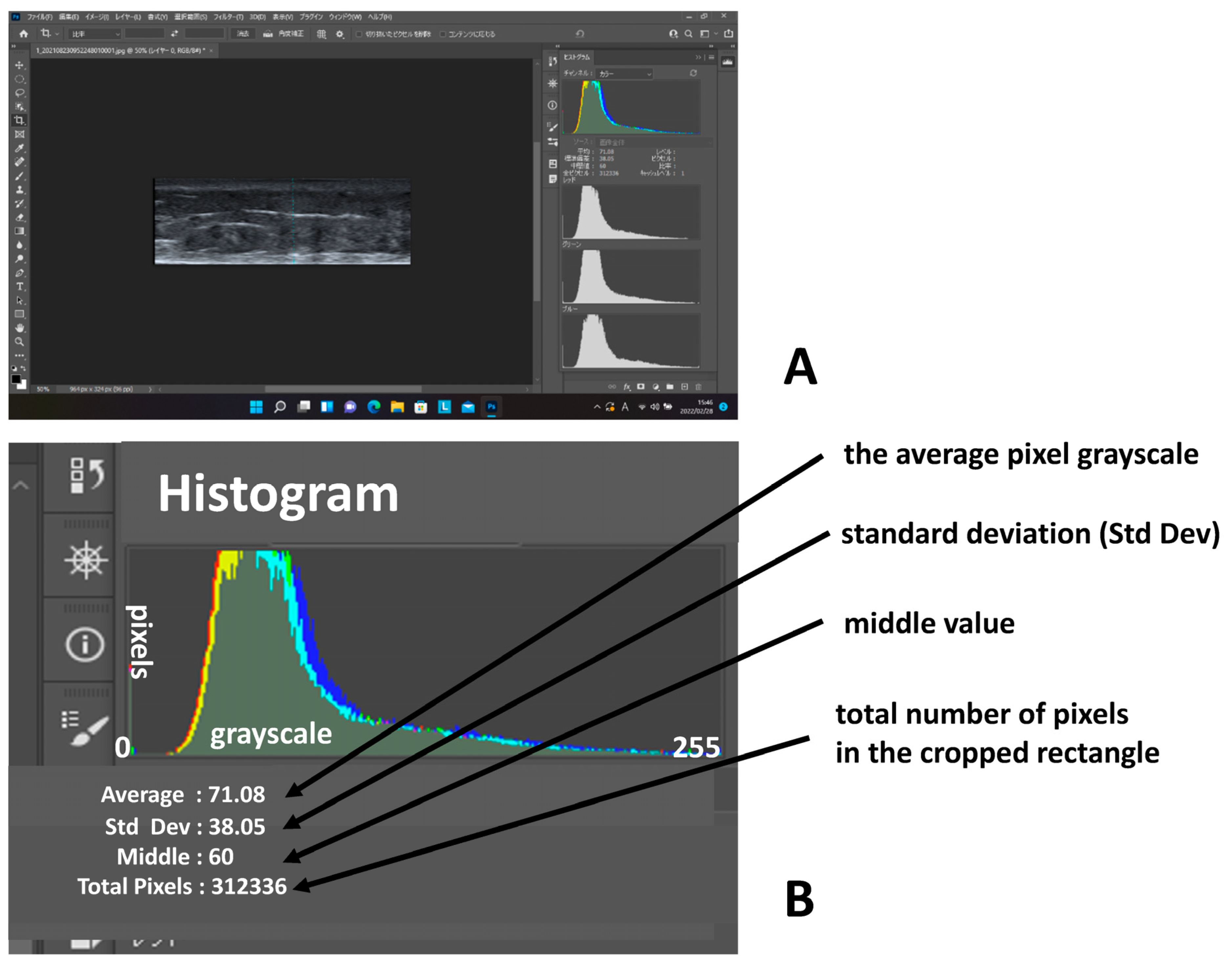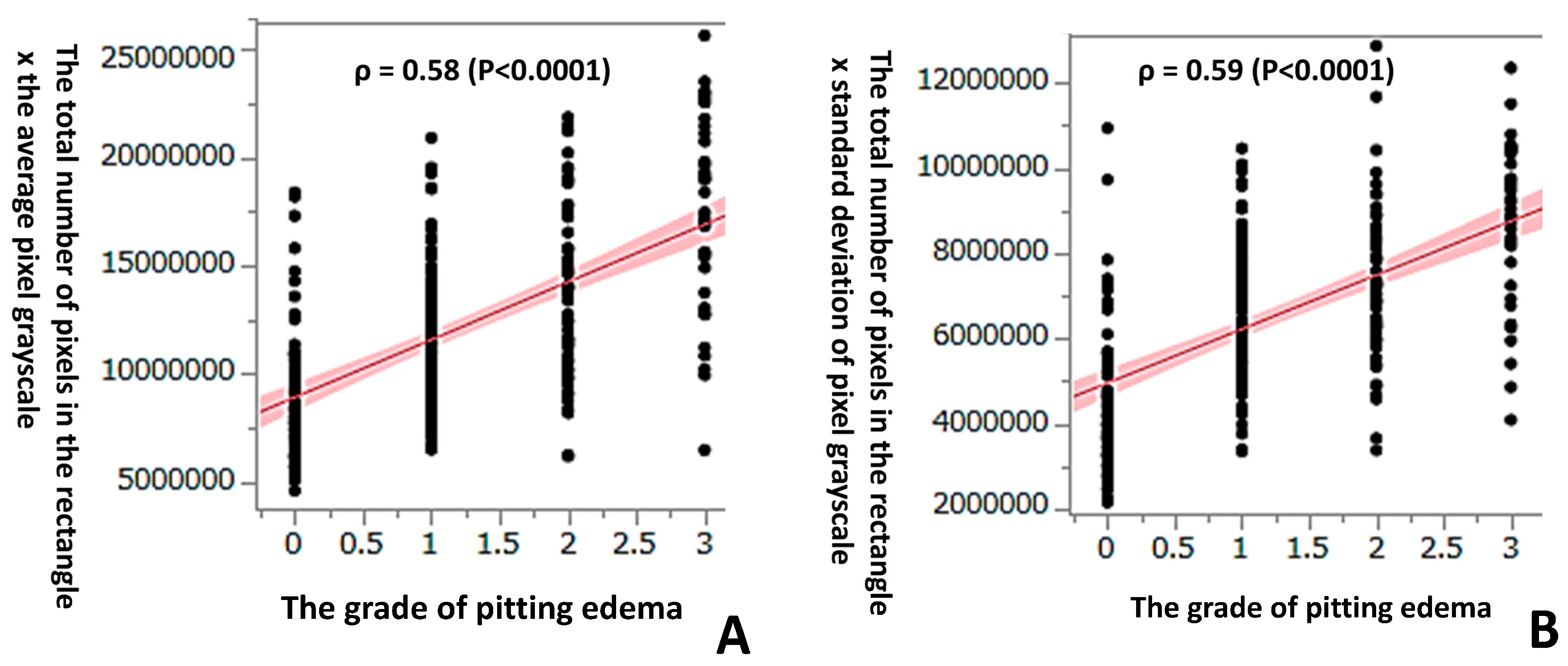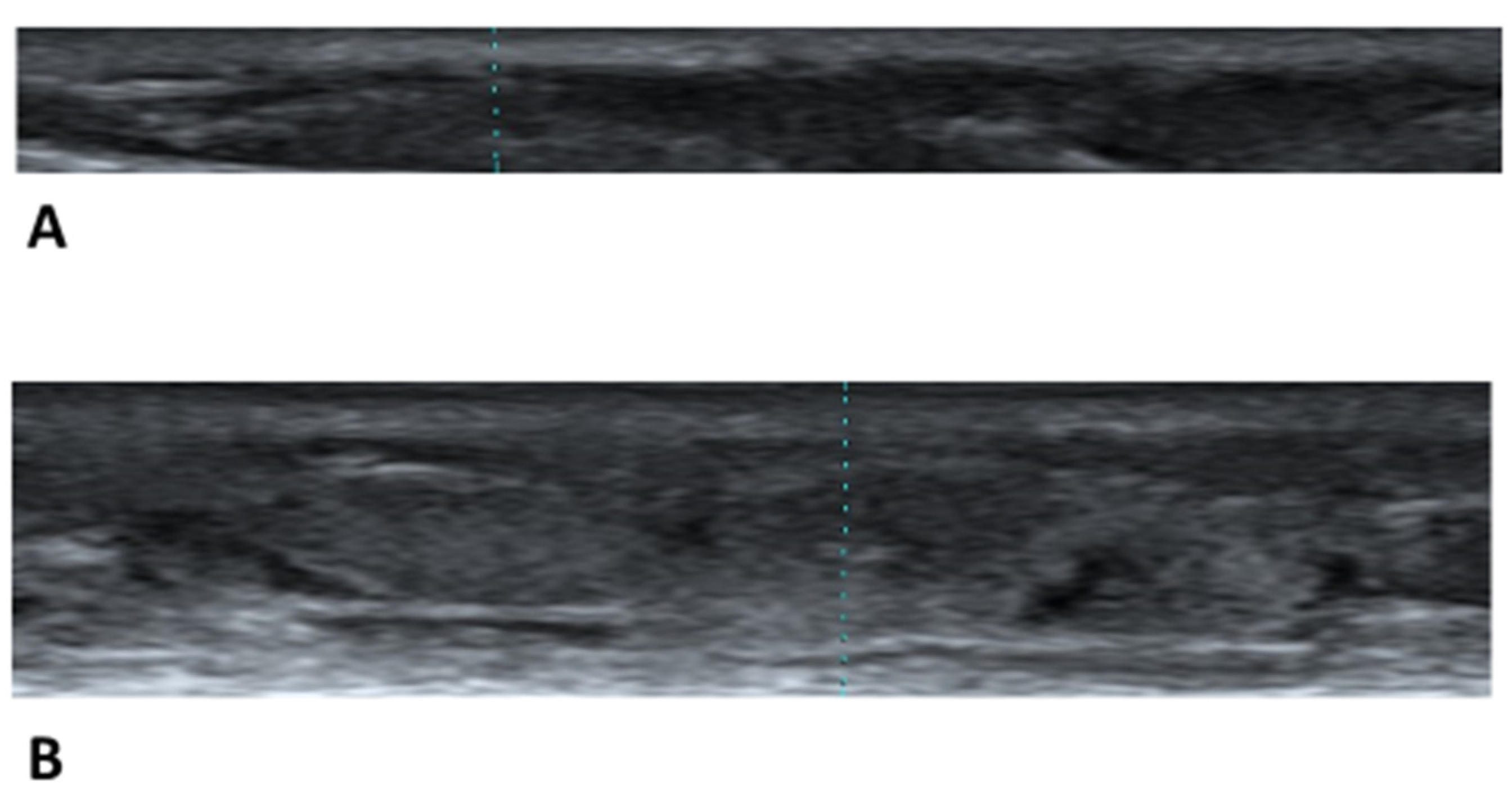A Histogram Analysis of the Pixel Grayscale (Luminous Intensity) of B-Mode Ultrasound Images of the Subcutaneous Layer Predicts the Grade of Leg Edema in Pregnant Women
Abstract
1. Introduction
2. Materials and Methods
2.1. Study Subjects and Study Approval
2.2. Ultrasound Images of the Skin with Leg Edema
2.3. The Analysis of the Pixel Grayscale (Luminous Intensity) of the Leg Skin
2.4. The Degree of Pitting Edema of the Lower Leg Skin
2.5. Statistical Analysis
3. Results
3.1. The Grades of Lower Leg Skin Edema
3.2. The Relationship between the Lower Leg Skin Data in the Histogram of the Image Editing Software Program and the Grade of Pitting Edema
4. Discussion
5. Conclusions
Author Contributions
Funding
Institutional Review Board Statement
Informed Consent Statement
Data Availability Statement
Conflicts of Interest
References
- Trayes, K.P.; Studdiford, J.S. Edema: Diagnosis and management. Am. Fam. Phys. 2013, 88, 102–110. [Google Scholar]
- Kaulesar Sukul, D.M.; den Hoed, P.T.; Johannes, E.J.; van Dolder, R.; Benda, D. Direct and indirect methods for the quantification of leg volume: Comparison between water displacement volumetry, the disk model method and the frustum sign model method, using the correlation coefficient and the limits of agreement. J. Biomed. Eng. 1993, 15, 477–480. [Google Scholar] [CrossRef] [PubMed]
- Stranden, E. A comparison between surface measurements and water displacement volumetry for the quantification of leg edema. J. Oslo. City. Hosp. 1981, 31, 153–155. [Google Scholar] [PubMed]
- Yanagisawa, N.; Koshiyama, M.; Watanabe, Y.; Sato, S.; Sakamoto, S. A quantitative method to measure skin thickness in leg edema in pregnant women using B-scan portable ultrasonography: A comparison between obese and non-obese women. Med. Sci. Monit. 2019, 25, 1–9. [Google Scholar] [CrossRef]
- Ikuta, E.; Watanabe, Y.; Yanagisawa, N.; Nakagawa, M.; Ono, A.; Seki, K.; Oowaki, M.; Koshiyama, M.; Sakamoto, S. Measurement of women’s leg edema using ultrasonograohy. Women’s Health Open J. 2020, 6, 5–7. [Google Scholar] [CrossRef]
- Busti, A.J. Pitting Edema Assessment. Evidence-Based Medicine. Consult. Available online: https://www.ebmconsult.com/articles/pitting-edema-assessment (accessed on 15 February 2023).
- Wang, Z.; Liang, X.; Wu, Z.; Lin, J.; Huang, J. A novel method for measuring anterior segment area of the eye on ultrasound biomicroscopic images using photoshop. PLoS ONE 2015, 10, e0120843. [Google Scholar]
- Sotomayor, C.G.; Benjamens, S.; Dijkstra, H.; Yakar, D.; Moers, C.; Bakker, S.J.; Pol, R.A. Introduction of the Grayscale Median for Ultrasound Tissue Characterization of the Transplanted Kidney. Diagnostics 2021, 11, 390. [Google Scholar] [CrossRef] [PubMed]
- Photoshopessentials Com. How to Read and Understand Image Histograms in Photoshop. Available online: https://www.photoshopessentials.com/photo-editing/how-to-read-and-understand-image-histograms-in-photoshop/ (accessed on 15 February 2023).
- Adobe. Com. View Histograms and Pixel Values. Available online: https://helpx.adobe.com/photoshop/using/viewing-histograms-pixel-values.html (accessed on 15 February 2023).
- Banba, A.; Koshiyama, M.; Watanabe, Y.; Makino, K.; Ikuta, E.; Yanagisawa, N.; Ono, A.; Nakagawa, M.; Seki, K.; Sakamoto, S.; et al. Measurement of skin thickness using ultrasonography to test the usefulness of elastic compression stockings for leg edema in pregnant women. Healthcare 2022, 10, 1754. [Google Scholar] [CrossRef] [PubMed]
- Suehiro, K.; Morikage, N.; Murakami, M.; Yamashita, O.; Ueda, K.; Samura, M.; Nakamura, K.; Hamano, K. Subcutaneous tissue ultrasonography in legs with dependent edema and secondary lymphedema. Ann. Vasc. Dis. 2014, 7, 21–27. [Google Scholar] [CrossRef] [PubMed]
- Caggiati, A. Ultrasonography of skin changes in legs with chronic venous disease. Eur. J. Vasc. Endovasc. Surg. 2016, 52, 534–542. [Google Scholar] [CrossRef] [PubMed]
- Pedro, L.M.; Pedro, M.M.; Goncalves, I.; Carneiro, T.F.; Balsinha, C.; Fernandes, R.F.; Fernandes, J.F. Atheroma plaque of the carotid bifurcation: How to identify an “active” lesion? Rev. Port. Cardiol. 1999, 18, 699–708. [Google Scholar] [PubMed]
- Lal, B.K.; Hobson, R.W., II; Pappas, P.J.; Kubicka, R.; Hameed, M.; Chakhtura, E.Y.; Jamil, Z.; Padberg, F.T., Jr.; Haser, P.B.; Durán, W.N. Pixel distribution analysis of B-mode ultrasound scan images predicts histologic features of atherosclerotic carotid plaques. J. Vasc. Surg. 2002, 35, 1210–1217. [Google Scholar] [CrossRef] [PubMed]
- Lee, K.; Chung, H.; Park, Y.; Sohn, J. Efficacy of intravitreal anti-vascular endothelial growth factor or steroid injection in diabetic mascular edema according to fluid turbidity in optical coherence tomography. Korean J. Ophthalmol. 2014, 28, 298–305. [Google Scholar] [CrossRef] [PubMed]
- Nam, S.J.; Yoo, J.; Lee, H.S.; Kim, E.K.; Moon, H.J.; Yoon, J.H.; Kwak, J.Y. Quantitative evaluation for differentiating malignant and benign thyroid nodules using histogram analysis of grayscale sonograms. J. Ultrasound Med. 2016, 5, 775–782. [Google Scholar] [CrossRef] [PubMed]
- Calvo-Lobo, C.; Useros-Olmo, A.I.; Almazan-Polo, J.; Martin-Sevilla, M.; Remero-Morales, C.; Sanz-Corbalan, I.; Rodriguez-Sanz, D.; Lopez-Lopez, D. Quantitative ultrasound imaging pixel analysis of the intrinsic plantar muscle tissue between hemiparesis and contralateral feet in post-stroke patients. Int. J. Environ. Res. Public. Health 2018, 15, 2519. [Google Scholar] [CrossRef] [PubMed]
- Abagge, K.T.; de Oliveira Sandri, C.; Sakai, L.S.M.; Mussato, L.P.; Petterle, R.R.; de Carvalho, V.O.O. Colorimetric analysis of images in the follow-up of infatile hemangiomas. Pediatr. Dermatol. 2020, 37, 622–625. [Google Scholar] [CrossRef] [PubMed]
- Soni, N.J.; Dreyfuss, Z.S.; Ali, S. Pluural fluid echogenicity measured by ultrasound image pixel density to differentiate transu dative versus exudative pleural effusions. Ann. ATS 2022, 19, 857–860. [Google Scholar] [CrossRef] [PubMed]





Disclaimer/Publisher’s Note: The statements, opinions and data contained in all publications are solely those of the individual author(s) and contributor(s) and not of MDPI and/or the editor(s). MDPI and/or the editor(s) disclaim responsibility for any injury to people or property resulting from any ideas, methods, instructions or products referred to in the content. |
© 2023 by the authors. Licensee MDPI, Basel, Switzerland. This article is an open access article distributed under the terms and conditions of the Creative Commons Attribution (CC BY) license (https://creativecommons.org/licenses/by/4.0/).
Share and Cite
Ikuta, E.; Koshiyama, M.; Watanabe, Y.; Banba, A.; Yanagisawa, N.; Nakagawa, M.; Ono, A.; Seki, K.; Kambe, H.; Godo, T.; et al. A Histogram Analysis of the Pixel Grayscale (Luminous Intensity) of B-Mode Ultrasound Images of the Subcutaneous Layer Predicts the Grade of Leg Edema in Pregnant Women. Healthcare 2023, 11, 1328. https://doi.org/10.3390/healthcare11091328
Ikuta E, Koshiyama M, Watanabe Y, Banba A, Yanagisawa N, Nakagawa M, Ono A, Seki K, Kambe H, Godo T, et al. A Histogram Analysis of the Pixel Grayscale (Luminous Intensity) of B-Mode Ultrasound Images of the Subcutaneous Layer Predicts the Grade of Leg Edema in Pregnant Women. Healthcare. 2023; 11(9):1328. https://doi.org/10.3390/healthcare11091328
Chicago/Turabian StyleIkuta, Eri, Masafumi Koshiyama, Yumiko Watanabe, Airi Banba, Nami Yanagisawa, Miwa Nakagawa, Ayumi Ono, Keiko Seki, Haruki Kambe, Taiki Godo, and et al. 2023. "A Histogram Analysis of the Pixel Grayscale (Luminous Intensity) of B-Mode Ultrasound Images of the Subcutaneous Layer Predicts the Grade of Leg Edema in Pregnant Women" Healthcare 11, no. 9: 1328. https://doi.org/10.3390/healthcare11091328
APA StyleIkuta, E., Koshiyama, M., Watanabe, Y., Banba, A., Yanagisawa, N., Nakagawa, M., Ono, A., Seki, K., Kambe, H., Godo, T., Sakamoto, S.-i., Hara, Y., & Nakajima, A. (2023). A Histogram Analysis of the Pixel Grayscale (Luminous Intensity) of B-Mode Ultrasound Images of the Subcutaneous Layer Predicts the Grade of Leg Edema in Pregnant Women. Healthcare, 11(9), 1328. https://doi.org/10.3390/healthcare11091328







